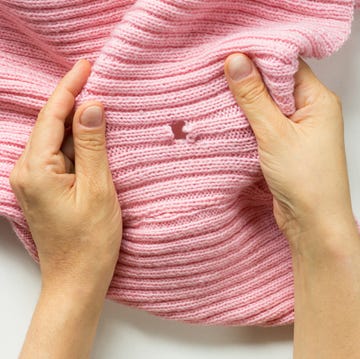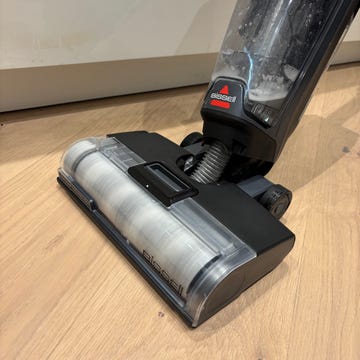At last, spring has sprung and things are finally heating up! But be prepared, because along with the blooming flowers and warmer days, comes the inevitable threat of clothes moths.
At this time of year, clothes moths will hatch and become abundant. Once air bound, they’re on the hunt for a dark, warm, humid space to lay eggs, ideally with snacks galore for their larvae, aka your wardrobe! If a moth finds its way in, your clothes will pay the price; with holes popping up all over natural fibres, including wool, silk and cotton. Even your carpets could be at risk!
But before you close all windows, know that there are ways to stop moths from nesting in your wardrobe in the first place. In fact, we’ve rounded up 7 ways to prevent moths and protect your clothes all year around.
1. Clean your clothes
What are moths attracted to? For one, it’s wool, silk and other natural fibres for larvae to make a meal of. But if your natural fibres are stained with sweat and food residue, then that’s all the better.
If you’re conscious of moths invading the wardrobe, you’ll need to keep unwashed laundry out; any stains will make the item(s) more alluring. Even if there are no obvious stains, clothing that’s been worn can still attract moths via any skin cells and body oils you leave behind. So you’ll either need to wash items (especially those made of natural fibres) between uses or wear an extra layer underneath to limit exposure.
Natural fibres, such as silk and wool, usually require a delicate wash cycle (if machine-washable) with a delicate detergent, such as Ecover Delicate Laundry Detergent. Use a mesh laundry bag to make the cycle less abrasive, and pad out the load with sheets if necessary. Alternatively, if the care label advises you to hand wash, you should do that instead.
2. Clean your wardrobe
It’s not enough that your clothes are clean; the inside of your wardrobe needs to be spotless, too, otherwise moths will be drawn to the skin cells in the dust. Once your clothes are out, wipe over the floor and shelves with a microfibre cloth or use the upholstery attachment on your vacuum cleaner.
Look out for mould in your wardrobe. That’s a sign that the space is humid, which makes it more inviting to moths (more on this later). Treat with a mould remover that’s suitable for the surface, such as Furniture Clinic Mould Remover Spray. Alternatively, for sealed wood, you can treat with white vinegar. Simply spritz it on to the mould, leave for an hour, and then scrub it away. Always wear protective gear when removing mould, including gloves, a mask and goggles.
Once free of mould, you can use a sealed wood cleaner or multi-surface cleaner for the rest of the space (including the outside). Then leave to dry.
3. Store your knits securely
Sadly, moth activity isn’t limited to your wardrobe. As we make the switch from our winter to summer clothes, they often find their way into long-term storage, too. By the time autumn comes round, your favourite knits are peppered with holes – ruined when you need them most. But, by storing them safely and securely, you can avoid this heartbreak.
There are storage bags designed to keep clothes moths at bay. If you’re storing wool and cashmere, there are breathable options, too, to keep woollens fresh while blocking moths out. Examples of storage bags include Lakeland Store & Protect Clothes Bags and Total Wardrobe Care Cashmere Storage Bag.
Remember to wash and fully dry your clothes before storing them for the season. This prevents bacterial growth and a musty smell when the time comes to get them out again.
4. Hang moth deterrents
There are plenty of moth deterrents you can hang in your wardrobe and you can hang these all year around – don’t rely on them solely when you suspect moths!
Cedar oil is a common deterrent and it’s long-lasting. Look out for cedarwood and cedar ring products you can place or hang in your wardrobe. Because the smell eventually fades, you should sand your cedarwood every six to 12 months with sandpaper. This will release fresh oil. Replace as and when needed.
If the smell of cedar’s not for you, there are other natural oils that can help. For instance, Clothes Doctor offers Natural Moth Repellent Scent Bags that contain lavender, sandalwood and eucalyptus. While Total Wardrobe Care has a May Chang blend.
5. Apply linen sprays
Alternatively, there are products that are designed to be spritzed in the wardrobe directly for the same impact. Total Wardrobe Care offers three Linen Spray fragrances, while Ready Steady Defend offers a Moth Repellent Spray with a plant-based formula, and the latter can be spritzed on your clothes, too.
For direct defence on clothes, Clothes Doctor also sells a Knitwear Mist with cedarwood and vanilla essence. If you want to improvise, switch to a detergent or fabric conditioner with natural moth-deterring fragrances. For instance, there’s a Laundry Detergent available from Method with a wild lavender fragrance. But, keep in mind, your delicates will need a gentle detergent, such as Lona Scott Lavender Cashmere Detergent.
6. Keep your wardrobe dry and ventilated
To make the environment less inviting to moths, your wardrobe needs to be dry and airy.
The first step is to keep your wardrobe decluttered, rather than crammed with clothes. That way, the space is better ventilated, with fewer places for moths to hide in. Sort through items by category, organising into piles to keep, donate, sell and recycle, and only replace once you’ve finished sorting (so you’re not tempted to squeeze in more than is needed).
To keep the space dry, avoid storing items that are still damp, such as laundry that hasn’t quite finished drying or coats that have been caught in the rain. Damp clothes will contribute to a humid space, encouraging moths as well as mould. Ensure items are fully dry before storing.
7. Vacuum and clean carpets
As we’ve mentioned before, moths aren’t confined to your wardrobe. The larvae will happily make a meal of your carpet, too – which may well happen if your wardrobe is successfully deterring them.
Vacuuming and cleaning your carpets routinely will prevent moths, plus remove any that may have already taken up residence. By removing dust, food residue and stains, you’ll make the space less appealing. And, if there is a moth problem, you’ll vacuum away any eggs and larvae in the process. Just make sure you can reach into dark and hidden areas, such as under furniture. If you have moths, you’ll need to remove the vacuum’s bag and contents and discard it outside immediately once you’ve finished cleaning.






















